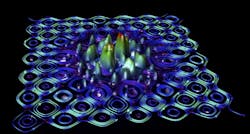Laser pulses make electrons produce gamma rays, then matter/antimatter pairs of particles
It is rare to find antimatter on Earth, but it is found here and there around the universe. Amazingly, antimatter can be created out of thin air—scientists can create blasts of matter and antimatter simultaneously using high-energy laser pulses.
When electrons oscillate, they give off light; if they move very fast in oscillation, they give off a lot of light. An effective way to make them oscillate is to blast them with high-energy laser pulses. The electrons move almost as fast as light and generate beams of gamma rays. The resulting light beam is narrow, about the thickness of a sewing needle even a few feet away from its source.
When gamma rays made by electrons interact, they can create matter-antimatter pairs—an electron and a positron. Now, scientists have developed a new trick to create these matter-antimatter pairs even more efficiently.
"We developed an optical trap which keeps the electrons from moving too far after they emit gamma rays," says Marija Vranic from the University of Lisbon, who is presenting her work at the American Physical Society Division of Plasma Physics meeting (Portland, OR; November 5-9, 2018). "They get trapped where they can be hit again by the powerful laser pulses. This generates more gamma rays, which creates even more pairs of particles."
This process repeats, and the number of pairs grows very fast in a cascade. The process continues until the particles that have been created are very dense.
Cascades are thought to occur naturally in faraway corners of the universe. For example, rapidly rotating neutron stars called pulsars have extremely strong magnetic fields, a trillion times stronger than the magnetic fields on Earth, that can produce cascades.
Studying cascades in the laboratory could shed light on mysteries related to astrophysical plasmas in extreme conditions. These beams can also have industrial and medical applications for noninvasive high-contrast imaging. Further research is necessary to make the sources cheaper and more efficient so that they can become widely available.
Source: https://www.eurekalert.org/pub_releases/2018-11/aps-lba110218.php

John Wallace | Senior Technical Editor (1998-2022)
John Wallace was with Laser Focus World for nearly 25 years, retiring in late June 2022. He obtained a bachelor's degree in mechanical engineering and physics at Rutgers University and a master's in optical engineering at the University of Rochester. Before becoming an editor, John worked as an engineer at RCA, Exxon, Eastman Kodak, and GCA Corporation.
